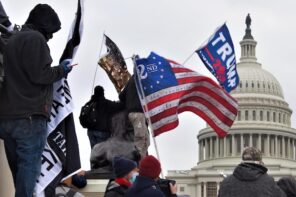With the discovery of Dylann Roof’s manifesto this weekend, it becomes much more difficult to dismiss his attack on the AME Church as mental illness or evidence of “anti-Christian hostility.” It seems clear that he was a self-radicalized domestic terrorist. Roof may have been a “troubled loner,” but his decision to commit violence was made in the context of a larger culture of racism.
As a religion scholar, I see Roof’s fantasy of sparking a race war as an example of millennial violence; conservative declension narratives and calls to “take our country back” are religious language as much as political rhetoric.
Without giving details as to how are our country was “lost” or what taking it back would actually mean, this rhetoric spins a narrative of a fallen nation as well as a prophecy of a redeemed and perfected one. It is precisely the troubled loners—those who find nothing of value in the present order—who become the most invested in these prophecies.
Scholars who study apocalyptic movements long have noted that radical political movements such as Marxism and Nazism are founded on prophecies of a secular apocalypse. Like religious prophecies of the apocalypse, these movements claim that history will inevitably lead to a new and “perfect” world order.
In some cases it’s easy to see how these political visions were adapted from ideas of Christ’s millennial kingdom; after all, the Nazi Third Reich was expected to last 1,000 years. Although Roof’s manifesto is brief and poorly written, it contains the elements of a racist millennial order, laying out his opinion of blacks, whites, Hispanics, Asians, and Jews and assesses what role they might have in his ideal world—even speculating about an alliance with “racist Asians.”
The millennial imagination is powerful because it frequently translates into action. The political philosopher Eric Voegelin coined the term “immanentize the eschaton” to describe the goal of political movements that seek to bring about the millennial kingdom through human efforts.
White supremacist ideology typically imagines apocalyptic violence and race war as the means of ushering in its millennial kingdom. In Mein Kampf, Hitler wrote, “The main difficulty is not to establish a new order of things but to clear the ground for its establishment.”
The classic text of racist apocalypticism is The Turner Diaries, published in paperback in 1978 and written by Hitler admirer and influential white supremacist William Luther Pierce (pseudonym: Andrew Macdonald). The novel describes an alternate timeline in which a secretive group of Jews has risen to power in the United States, confiscated all firearms, and legalized the rape of white women in the name of combatting racism. A white supremacist group called “The Order” resists this regime by waging a terror campaign which triggers a civil war in which more whites rally to the cause. Ultimately, The Order succeeds in taking over America after the protagonist, Earl Turner, flies a crop-duster containing a nuclear warhead into the Pentagon. The novel culminates in a nuclear genocide in which all non-white races are exterminated.
The ADL calls Pierce’s novel “The Bible of the Right Wing” and it is, in many ways, a religious text. Its conclusion describes how “the dream of a White world finally became a certainty” through Turner’s martyrdom. In Pierce’s millennial vision, a new calendar is created marking time from the beginning of his apocalyptic race war. If Roof did not read The Turner Diaries, he certainly had contact with people who had.
In the days after the attack on the A.M.E. Church, discussion focused on how Roof’s actions were related to a wider culture of racism, both in South Carolina and throughout American society. It seems that within the culture of racist apocalypticism there is a division of labor between dreamers and doers, prophets and martyrs.
Numerous hate crimes and terror plots were inspired by The Turner Diaries, including Timothy McVeigh’s attack on the Oklahoma City Building in 1995. Turner and his allies blow up the FBI headquarters using a fertilizer bomb packed into a truck—the same method used by McVeigh. Not surprisingly, McVeigh was an avid fan of The Turner Diaries, mailing it to friends and selling copies at gun shows. Pierce did not applaud McVeigh’s actions but rather denounced his attempt to immanentize the eschaton, even while his National Alliance continued to campaign.
Those seeking to hermetically seal Roof’s actions from a larger cultural pattern will emphasize that he only completed the ninth grade, that he was unemployed, that he likely abused drugs, and that we was arrested following a strange incident at a mall. But these details suggest exactly the sort of person who might become invested in a millennial prophecy. In the current order, Roof was a loser—perhaps more so because of his privilege as a white male and his limited education.
But in a racist apocalyptic fantasy, he could be a hero of world-changing significance. While apocalypticism focuses on the future, it is really about a desire to escape the unhappiness of the present. Hitler wrote that, “Weltanschauung [worldview] represents a declaration of war against an existing order of things, against present conditions, in short, against the established Weltanschauung.” Roof’s fantasy of sparking a race war may have also been a declaration of war against his own present conditions.
As we continue to learn more about Roof and the motivations for his actions, it is important to analyze not only Roof’s circumstances but also the forces that shaped his imagination. What did he think might happen after his attack and who were the voices that contributed to this apocalyptic vision? We need to answer these questions, because it’s a vision that other angry young white men are certainly contemplating.




